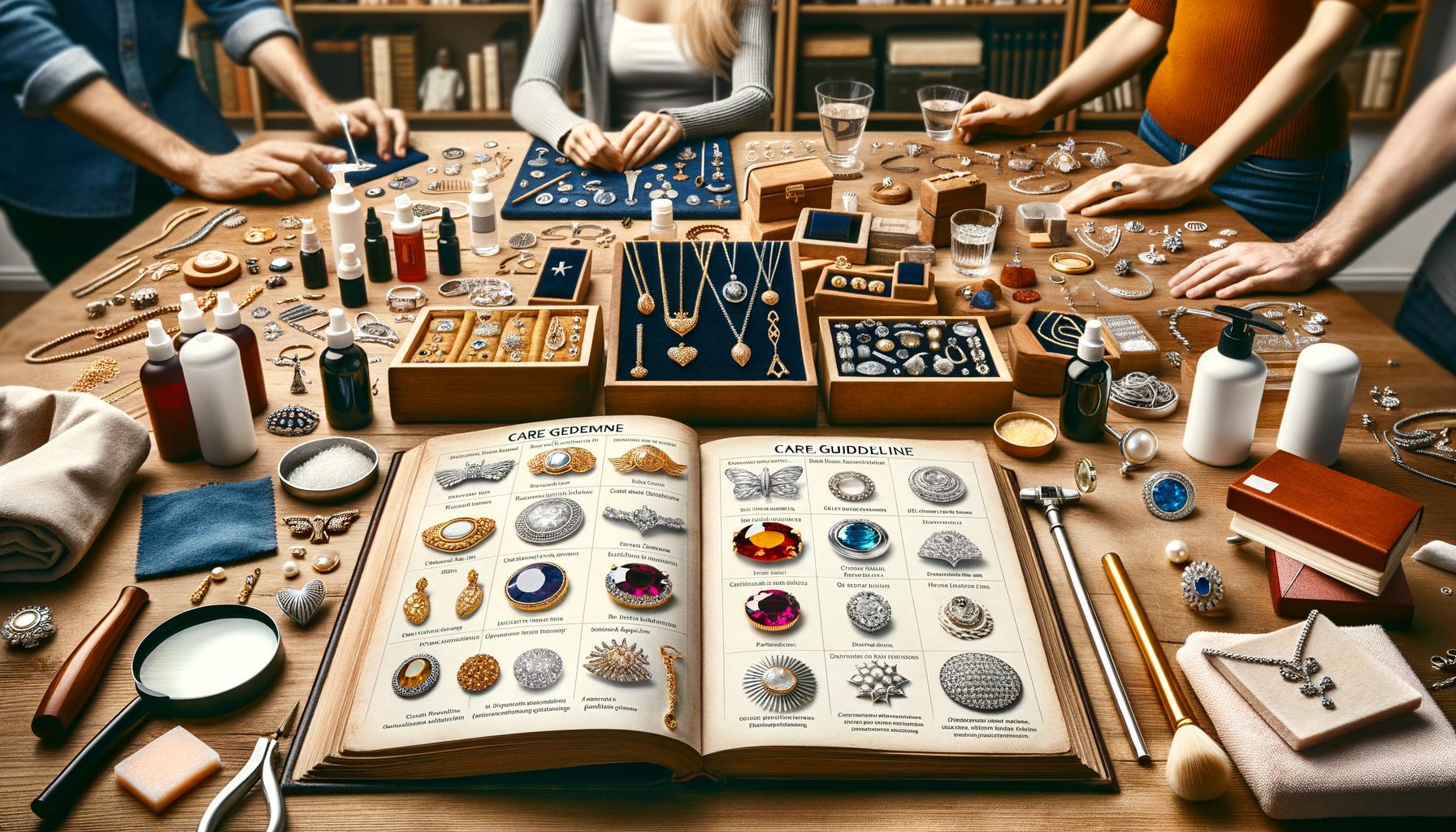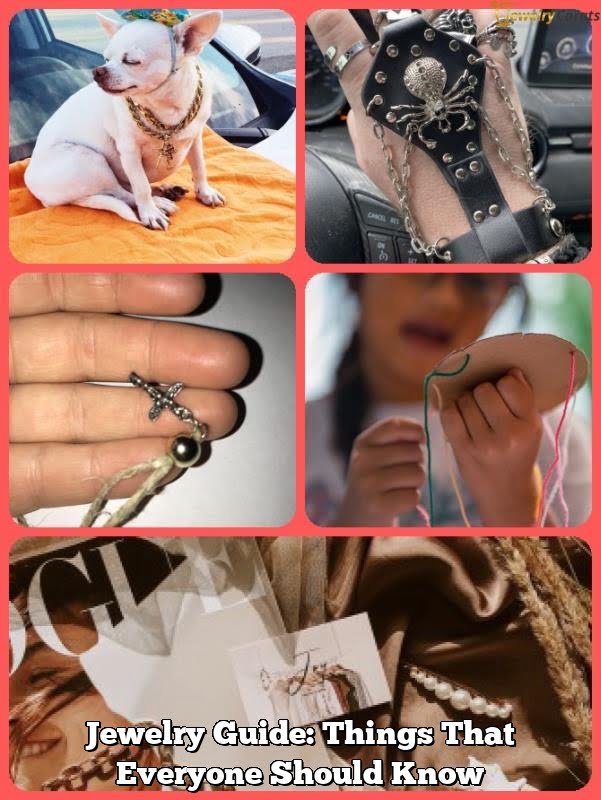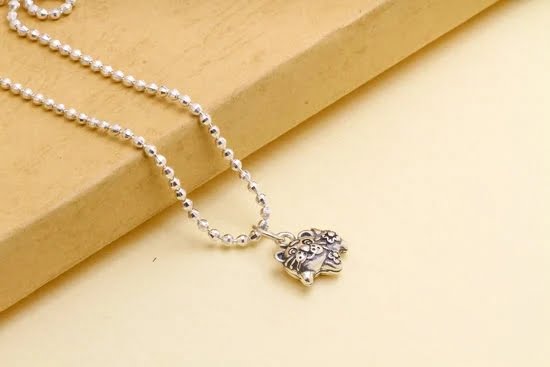Proper jewelry care is essential in preserving the beauty and longevity of your favorite pieces. Without a doubt, different jewelry materials require specific maintenance routines to ensure they remain in pristine condition. Whether you’re dealing with the timeless allure of gold, the classic elegance of silver, or the sophisticated charm of pearls, knowing how to care for different jewelry materials: a comprehensive guide can save you from unwarranted wear and damage.
Jewelry enthusiasts often overlook that each material-be it metals like gold and platinum or organic substances like pearls-has its own set of characteristics and vulnerabilities. For instance, while gold might lose some of its luster if not polished regularly, silver is prone to tarnishing due to its high reactivity with air and moisture.
Additionally, gemstones such as diamonds have distinct care requirements compared to softer stones like emeralds. By understanding these differences, you can tailor your cleaning and storage methods accordingly.
This guide offers an extensive overview of various jewelry materials and their specific care protocols. From the right cleaning solutions for silver pieces to effective storage tips for delicate pearls, each section aims to equip you with practical advice. So whether you’re a seasoned collector or someone who cherishes a few heirloom pieces, this comprehensive guide will help you keep your cherished items looking their best for years to come.
Gold Jewelry Care
Gold is cherished for its timeless elegance and brilliance, making it a popular choice for various jewelry pieces. However, despite its durability, gold requires proper care to maintain its luster over time. Understanding gold’s properties, such as karat ratings and alloys, is essential for effective cleaning and maintenance.
First and foremost, knowing the karat of your gold jewelry can assist in selecting the appropriate cleaning methods. Gold is often alloyed with other metals to improve its strength-24-karat gold being pure gold and typically too soft for everyday wear. Lower karats, like 18K or 14K, contain more alloy metals such as copper or silver.
To clean gold jewelry at home, it’s recommended to use mild soap and water along with a soft cloth or brush. Avoid abrasive materials that can scratch the surface. For deeper cleaning needs, professional polishing might be necessary to restore the original shine without damaging the piece.
Proper storage also plays a pivotal role in preserving gold jewelry. To prevent scratching and tarnishing-a common issue even with higher-karat pieces-store each item separately in a soft pouch or lined box. It’s crucial to avoid direct exposure to harsh chemicals like chlorine or household cleaning agents that could dull the metal’s finish over time. Additionally, here are some tips to keep in mind:
- Always remove your gold jewelry before swimming.
- Store pieces in a cool, dry place.
- Polish regularly to maintain shine.
A frequent mistake when caring for gold jewelry is failing to secure clasps and settings properly before storing them away-leading to potential damage or loss of stones over time. Also, wearing multiple pieces together without adequate separation can cause needless abrasions that diminish their beauty. By adhering to these best practices outlined in “How to Care for Different Jewelry Materials: A Comprehensive Guide“, you can ensure your treasured gold items remain radiant through years of enjoyment.
Silver Jewelry Care
Explanation of silvers reactivity to air and moisture:
Silver jewelry, while beautiful and timeless, is more reactive compared to some other precious metals. Pure silver, also known as fine silver, is relatively soft and can be prone to scratches and deformation, so it’s usually alloyed with other metals like copper to improve its durability. The most commonly used silver alloy in jewelry is sterling silver (92.5% silver and 7.5% other metals).
One notable characteristic of sterling silver is its tendency to tarnish when exposed to air and moisture over time. Tarnishing occurs because the copper in the alloy reacts with sulfur-containing substances in the atmosphere.
Cleaning methods: commercial silver cleaners vs. homemade solutions:
To maintain the luster of your silver jewelry, regular cleaning is essential. Commercial silver cleaners are widely available and offer an effortless way to remove tarnish; however, they often contain strong chemicals which might compromise the integrity of your pieces if not used correctly. Alternatively, homemade solutions can be just as effective and gentler on your silver jewelry.
A popular DIY method involves soaking your pieces in a solution of warm water mixed with mild dish soap for a few minutes. After soaking, gently rub them with a soft cloth or sponge before rinsing thoroughly in clean water and drying with a lint-free cloth.
Strategies for preventing tarnish:
Preventive care can significantly extend the period between cleanings and help preserve the brilliance of your silver jewelry. Storing pieces individually in anti-tarnish pouches or cloths reduces exposure to air and humidity, decelerating the tarnishing process. You may also consider placing silica gel packets inside your jewelry boxes-they absorb moisture from the air surrounding your jewels, reducing oxidation. Additionally, wearing your silver items frequently helps keep them polished naturally through regular contact with skin oils.
| Category | Recommendation |
|---|---|
| Storage | Use anti-tarnish pouches or silica gel packets |
| Cleaning Method | Mild dish soap solution or commercial cleaners |
| Tarnish Prevention | Store individually; frequent wear keeps pieces polished |
By following these guidelines within how to care for different jewelry materials: a comprehensive guide you’ll ensure that your treasured silver pieces remain sparkling for years to come. Employing both proactive prevention measures and gentle cleaning practices will maintain their beauty without causing damage over time.
Diamond and Gemstone Jewelry Care
Diamonds and gemstones are prized for their brilliance and beauty, but they require specialized care to maintain their luster. Each type of gemstone has unique characteristics that affect how it should be cleaned and stored. For instance, while diamonds rank 10 on the Mohs hardness scale, making them highly resistant to scratching, gems like opals and emeralds are softer and more prone to damage. It’s crucial to understand the specific needs of each stone.
When cleaning diamond and gemstone jewelry, general methods include using a mild soap solution with lukewarm water. Gently scrubbing with a soft toothbrush can remove dirt without causing scratches. Ensure the piece is properly rinsed to remove any soap residue. Ultrasonic cleaners may be used for diamonds but should be avoided for softer stones like emeralds or those with inclusions, as the vibrations can cause cracks or exacerbate existing ones.
It’s also essential to store diamond and gemstone jewelry carefully. To avoid scratches, store each piece separately in a soft-cloth pouch or a compartmentalized jewelry box. For added protection:
- Avoid exposing gemstones to harsh chemicals such as bleach or chlorine.
- Remove jewelry before engaging in heavy physical activities.
- Keep gemstones away from extreme temperature changes which might cause thermal shock.
Staying vigilant about these precautions will help preserve the integrity of your precious gems. If uncertainty arises on how to care for different jewelry materials: a comprehensive guide offers all-encompassing tips tailored to various types of jewels and ensures you can enjoy their splendor for years to come.
Pearl Jewelry Care
Pearl jewelry demands a unique care approach due to its organic origins and delicate nature. Unlike gemstones and metals, pearls are formed in mollusks and primarily consist of calcium carbonate, which makes them both precious and vulnerable. Understanding the specific needs of pearl jewelry is essential for maintaining its timeless elegance and lustrous appeal.
Gentle Cleaning Techniques to Maintain Luster
Pearls are remarkably sensitive to chemicals, abrasive materials, and excessive moisture. To clean your pearls without compromising their integrity, use a soft cloth dampened with lukewarm water.
Gently wipe each pearl individually to remove oils, sweat, or any impurities that may dull their shine over time. For more thorough cleaning, you can add a small drop of mild dishwashing soap to the water; however, it’s vital to avoid submerging your pearls completely or using harsh detergents that can erode their surface.
Storing Pearls to Prevent Dehydration and Scratching
Correct storage is crucial for preserving the luster and quality of your pearl jewelry. Pearls should be stored separately from other pieces in a soft cloth pouch or a lined jewelry box to prevent scratches caused by harder gemstones or metal settings.
Ensure the environment isn’t excessively dry; pearls benefit from slight humidity as dryness can lead them to become brittle over time. It’s also wise to keep pearl strands flat rather than hanging them to avoid stretching the silk threads they’re strung on.
Warning Against Common Cleaning Mistakes
While it might be tempting to treat your pearls like other types of jewelry when it comes to cleaning routines, certain practices can severely damage these organic gems. Never use ultrasonic cleaners, steamers, or abrasive brushes as these methods can crack or pit the surface of your pearls. Similarly, after wearing cosmetics or using hairspray and perfumes-which contain chemicals harmful to pearls-ensure you wipe down each piece thoroughly before storing it away.
For further assurance on how best practices align with professional advice for maintaining every type of adornment you own, consider consulting ‘how to care for different jewelry materials: a comprehensive guide.’ This resource presents intricate details geared towards ensuring all your cherished collections remain radiant through customized care regimes tailored individually for each material type within your trove of treasures.
Platinum Jewelry Care
Platinum is a highly durable metal favored for fine jewelry due to its impressive strength and natural shine. One of the key properties of platinum is its resistance to tarnishing and corrosion, making it an ideal choice for pieces that will be worn frequently. Despite its durability, understanding how to care for different jewelry materials: a comprehensive guide emphasizes that even robust metals like platinum require proper maintenance to keep their luster intact over time.
Cleaning and polishing platinum jewelry can be relatively straightforward but should be done with care. For everyday cleaning, you can use a mild dish soap mixed with warm water and a soft-bristled brush to gently scrub away dirt and debris.
Avoid using abrasive materials or harsh chemicals as they can scratch the surface of your platinum pieces. For more thorough polishing, consider investing in a professional polishing cloth specially designed for platinum, which can help restore its brilliant shine without causing damage.
Proper storage solutions are crucial in maintaining the quality of your platinum jewelry. Since platinum is scratch-resistant but not entirely scratch-proof, it’s important to store each piece individually in soft pouches or lined compartments within a jewelry box. This prevents contact with other items that could potentially cause scratches or dulling. Additionally, keeping platinum away from extreme temperatures and high humidity can further prevent any unnecessary wear and tear.
| Platinum Property | Care Tip |
|---|---|
| Durability | Store individually in soft pouches |
| Resistance to Tarnish | Avoid abrasive cleaners |
| Natural Shine | Use professional polishing cloths designed for platinum |
Costume Jewelry Care
When it comes to caring for costume jewelry, it’s essential to understand the diverse materials commonly used in its creation. Costume jewelry, unlike fine jewelry, often features an array of base metals, glass, plastics, and synthetic stones. These materials can be delicate and may not withstand the same cleaning techniques as more precious gems and metals. Knowing how to care for different jewelry materials: a comprehensive guide could make all the difference in maintaining their aesthetic appeal and longevity.
Effective Cleaning Methods
Cleaning costume jewelry requires gentle methods to avoid damaging its sometimes fragile components. For plastic pieces, a simple solution of mild soap and warm water works wonders. Use a soft cloth or toothbrush to gently scrub away dirt, paying special attention to intricate designs where grime might accumulate. Glass stones should be treated similarly but avoid soaking them for extended periods as moisture could seep into settings and cause discoloration or rusting of any metal parts.
On the other hand, base metal pieces may tarnish over time. A mixture of vinegar and baking soda can act as an excellent tarnish remover; however, this should be done with caution. Apply the mixture using a soft cloth rather than directly soaking the piece which could harm the finish or loosen any glue securing stones. For both plastic and base metals alike, make sure to thoroughly dry each piece post-cleaning to fend off any potential moisture damage.
Prolonging Life & Best Storage Practices
To extend the life of your costume jewelry, keep it away from harsh chemicals typically found in household cleaners or perfumed products that can cause reactions leading to discoloration or wear. Moreover, always put on your costume jewelry after applying makeup or hairspray to avoid contact with substances that can degrade their quality over time.
Storage is another critical aspect when it comes to preserving costume jewelry. Store pieces individually in soft pouches or lined compartments within a jewelry box to prevent them from scratching one another-a common issue given their mix of materials. For items with glued-in stones, it’s wise to store them away from high humidity environments as moisture can weaken adhesive bonds leading those beautiful elements at risk of falling out.
Employing these care techniques will help maintain your favorite costume pieces’ shine and functionality longer while being mindful that they require differing approaches compared with fine jewelry.
Mixed Material Jewelry Care
Caring for jewelry composed of mixed materials can pose unique challenges, given the varying requirements each material may have. For instance, a piece combining gold and pearls demands distinct approaches for cleaning and storage due to the divergent nature of the metals and organic elements. As such, an effective care routine for mixed material jewelry often involves understanding how to balance these needs without compromising any individual component.
When it comes to cleaning mixed materials, always prioritize the gentlest method applicable. For example, if your jewelry includes delicate gemstones alongside durable metals, use a mild soap solution with a soft brush to gently clean the entire piece. Avoid harsh chemicals that might damage sensitive components like pearls or opals. If in doubt, refer back to how to care for different jewelry materials: a comprehensive guide to find compatible cleaning methods tailored for each type included in your jewelry.
Proper storage is also crucial in prolonging the life of mixed material pieces. Consider storing them in separate compartments within a fabric-lined box to prevent scratching-particularly important when softer materials meet harder metals or stones. Additionally, ensure that items containing organic elements such as leather or wood are kept away from excessive moisture which could cause warping or mildew. Employing these combined strategies helps maintain the integrity and beauty of your multifaceted treasures.
Professional Maintenance and Repairs
Knowing when to seek professional help for your jewelry care is essential to maintaining the longevity and aesthetic appeal of your cherished pieces. Despite best efforts at home, some cleaning tasks and repairs call for expert intervention.
For instance, delicate adjustments like resizing a ring or resetting gemstones should only be handled by a qualified jeweler to ensure the integrity of the piece remains intact. The same goes for more complex needs such as re-plating gold or platinum jewelry, which requires specialized equipment and expertise to achieve a flawless finish.
Common repair services offered by professional jewelers encompass a wide range of tasks beyond simple cleaning. Resizing rings is one of the most frequent requests, allowing pieces to comfortably fit their owners again after weight changes or gifting situations.
Gemstone resetting is another critical service; stones can become loose over time due to general wear and tear, making it imperative that they are securely repositioned to prevent loss. Additionally, re-stringing pearls and beaded necklaces is crucial for preventing breakage from weakened threads.
Finding a reputable jeweler can make all the difference in guaranteeing high-quality workmanship and preserving the value of your jewelry. Start by seeking recommendations from friends or family members who have had positive experiences with local jewelers. Checking online reviews also provides insight into customer satisfaction and reliability.
It’s vital to choose someone accredited by recognized associations such as the Jewelers of America (JA) or International Gem Society (IGS), ensuring they adhere to industry standards. By following this approach alongside how to care for different jewelry materials: a comprehensive guide, you’ll be better equipped to keep your treasures in pristine condition over time.
Conclusion
In conclusion, understanding how to care for different jewelry materials: a comprehensive guide is essential for preserving the beauty and durability of your treasured pieces. From gold to silver, diamonds to pearls, and costume jewelry to mixed material pieces, each type of jewelry requires unique attention and care. By adhering to the specific cleaning methods, storage tips, and common mistakes outlined in this guide, you can ensure that your jewelry remains radiant and in pristine condition.
Regular maintenance is key to prolonging the life of your jewelry. Simple routines like gentle cleaning, proper storage techniques, and avoiding harsh chemicals can go a long way in maintaining the luster and integrity of your favorite accessories. Additionally, knowing when to seek professional help for repairs or professional polishing services can make a significant difference in keeping your collection looking its best.
We encourage you to use this guide as a reference whenever you’re uncertain about how to properly care for a particular piece. Jewelry often holds sentimental value as well as financial worth; investing time in its upkeep protects these cherished memories and keepsakes.
By following the steps in this comprehensive guide, you’ll be well-equipped to preserve the elegance and longevity of all your beloved jewelry pieces. And remember, proper care not only enhances the appearance of your jewels but also ensures their stories continue to shine through generations.
Frequently Asked Questions
How Do You Clean Different Types of Jewelry?
Cleaning jewelry requires different methods depending on the material and type of gems involved. For gold jewelry, a mild soap and warm water solution can work wonders, while silver may require a specialized polishing cloth to remove tarnish effectively.
For pieces with gemstones like diamonds or sapphires, opting for a gentle brush combined with lukewarm water ensures that dirt in crevices is adequately dislodged without damaging the setting. Pearls, on the other hand, necessitate extreme caution; wiping them gently with a soft, damp cloth keeps them pristine without compromising their delicate luster.
How to Properly Care for Your Jewelry?
Proper care for your jewelry involves numerous preventive measures to ensure longevity and maintain its beauty. Keeping pieces away from harsh chemicals or abrasive surfaces is crucial since these can mar both metal and gemstones. Storing jewelry in individual soft-lined compartments or pouches helps prevent scratches and tangles.
Regular cleaning tailored to each piece ensures that residues from lotions, perfumes, or sweat do not dull their appearance over time. Additionally, periodic professional evaluations are beneficial as jewelers can check for loose settings or potential wear that might go unnoticed by the untrained eye.
Why Jewelers Need to Understand the Properties of Different Materials in Order to Make Jewelry What Might Happen if a Jeweler Did Not Have This Knowledge?
A jeweler’s understanding of different materials’ properties is fundamental in creating durable and aesthetically pleasing pieces. For instance, knowing gold’s malleability allows jewelers to craft intricate designs without risking breakage during fabrication. Understanding gemstone hardness prevents accidental damage during cutting or setting processes.
Lack of this essential knowledge could lead to several issues: brittle materials might snap under pressure if worked incorrectly, softer stones could be scratched or shattered during routine handling, and metals unknowingly mismatched might corrode when combined in close contact over time. Thus, an educated jeweler ensures both quality craftsmanship and long-lasting customer satisfaction.

Welcome to my jewelry blog! My name is Sarah and I am the owner of this blog.
I love making jewelry and sharing my creations with others.
So whether you’re someone who loves wearing jewelry yourself or simply enjoys learning about it, be sure to check out my blog for insightful posts on everything related to this exciting topic!





